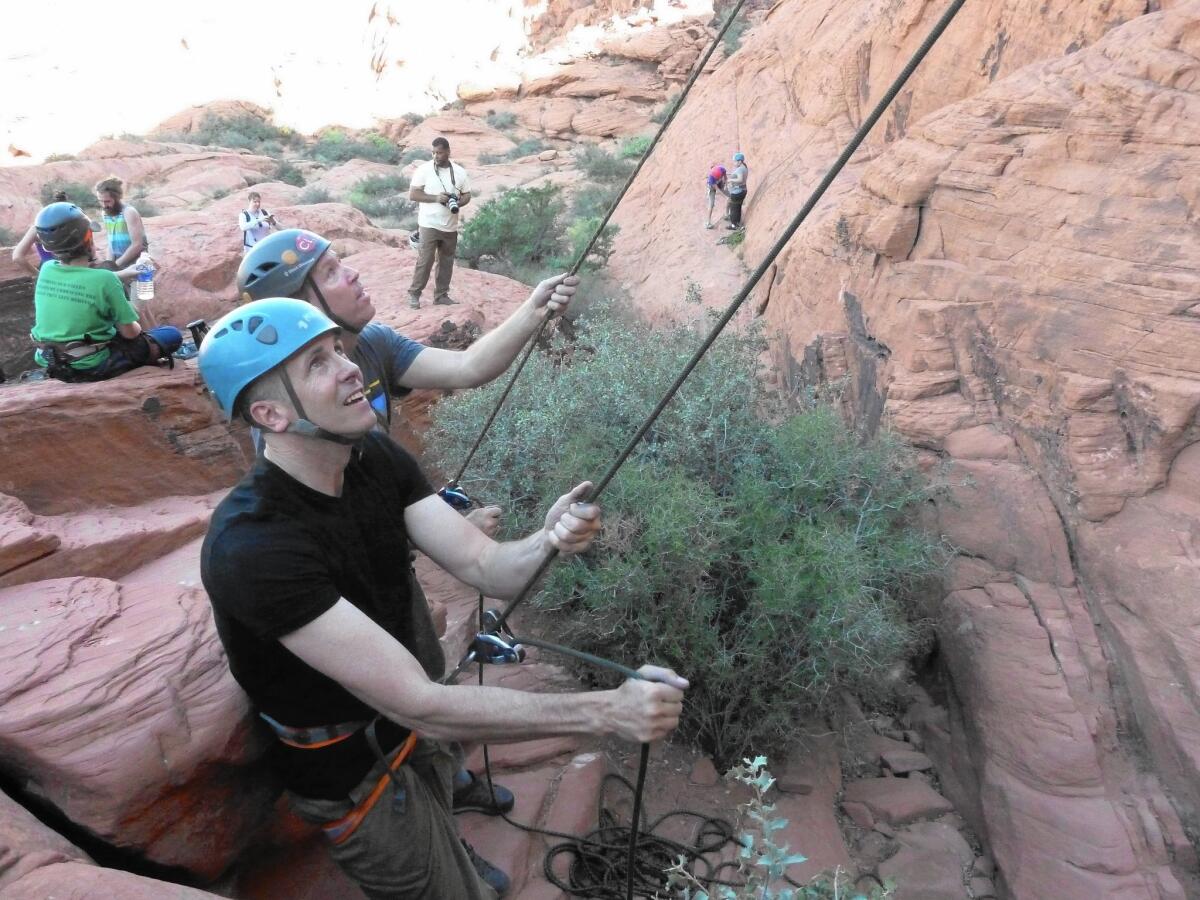A friendly Bureau of Land Management bureaucrat defies expectations – and gravity

- Share via
Reporting from LAS VEGAS — The tall, thin guy bounds up the trail toward the climbing wall like a caffeinated gazelle — this one with spiky hair and sunglasses.
Already shouldering thick belay ropes, he offers to help carry a heavy water cooler. His hat bears the insignia of another life: two decades spent as a federal smoke jumper.
Mike Tupper is just happy to be back here in the Red Rock Canyon National Conservation Area, where he cut his professional rock-climbing teeth. Recently, he was one of a few Bureau of Land Management officials from Washington to give a climbing tutorial here to children of U.S. service members killed in action, a lesson on how to enjoy the Western lands the federal agency is tasked to protect.
Tupper is primed for the job. Decades ago, he was a young man crazy for climbing, using two-by-fours to roll his truck over the tire guards so he could hit the walls before the park opened. Back in the day, he’d run the 13-mile scenic loop, then did it two more times atop his bike before attacking the wall. He’s a climbing legend here, pioneering hundreds of ascent routes, hammering in the belay bolts that would guide generations of climbers to follow.
“This,” he tells the novice climbers, motioning to the red-rock wall, “is the best sport in the world.”
At 56, Tupper is a new breed of BLM bureaucrat, an unlikely figure negotiating the dicey politics of an often-mistrusted federal agency known for its career ladder-climbers, not rock climbers.
NEWSLETTER: Get the day’s top headlines from Times Editor Davan Maharaj >>
He’s a native of the West, home to many BLM naysayers, with perhaps one of the weirdest professional resumes in Washington: a former counterculture athlete who wore his long beaded hair in dreadlocks, in shades of pink and white, and lived in a tent for months at a time.
In March, he became deputy assistant director of the BLM’s resources and planning office, the second in command at the largest of the agency’s eight directorates. At 6 feet 3 and 164 pounds, his body is still angular and athletic. Though his hair is shorter, he still sports the air of a rebel.
In Washington, a city famous for drab workday uniforms, Tupper dresses in tailored suits and fitted shirts, sporting colorful glasses to match his outfit. He’s known at the office as “Hollywood.”
But there’s more to Tupper than his suits. His energy is often in your face as he strives to change a BLM culture seen by many in the West as distant and elitist.
Charged with overseeing the BLM’s beleaguered wild horse and burro program, long at odds with activists who criticize the agency’s tactics, Tupper has reached out to critics. He has contacted wildlife and other groups suspicious of the BLM with offers to speak at their gatherings. He’s also met with congressional staffers to detail his more public-inclusive strategy for dealing with wild horses and other BLM projects.
Tupper winces at the idea of federal employees afraid to take initiative for fear of criticism from above. So he’s encouraged his 140 employees to take chances, make gut decisions. If they’re wrong, he says, he’ll take the heat.
If they succeed, they’ll get the reward. He carries a pocketful of quarters, which he flips one at a time to workers, along with a public shout-out for work that’s outside the box. It’s all symbolic, of course. He calls it the “Mike Tupper On the Spot Cash Incentive Reward Program.”
His approach is getting notice.
“He brings an energetic and fresh look, willing to collaborate,” said Ginger Kathrens, executive director of the Cloud Foundation, a wild horse and burro advocacy group. “It’s the first time I can remember that the BLM’s national office has invited any opinion from a major horse and burro advocacy group.”
Tupper also has supporters in his agency.
“He’s not afraid to take risks. In fire jumping and rock climbing, you can’t sit around making decisions; you go in and you do it,” said Peggy Olwell, manager of BLM’s plant conservation program. “Mike is a land manager and a land user.”
The transition from quirky outsider to power broker has been a precarious climb. Tupper grew up in Las Vegas; his parents sold and financed residential real estate deals. His heart wasn’t in the family business. One day in 1980, his father advised him to follow his own budding passions: backpacking, rock climbing, embracing the Western wilds.
Soon, Tupper’s father was dead from a heart attack. The son focused his hurt and anger into his outdoor pursuits. He was working as a BLM firefighter, rock climbing every chance he got.
“Rock climbing saved my life,” he says. “I missed my dad. I lost him too soon.”
Tupper met his best friend and rock-climbing partner Mike Ierien in a climbing class. “Tupper asks the instructor who the best climber is,” recalled Ierien, now a northern Nevada firefighter, saying the teacher sent Tupper his way.
“He walks up to me and says, ‘Are you Mike? Do you own a car?’ When I said I did, he says, ‘We’re going to make a great team.’ It’s been like that for 36 years.”
Soon both were working in the rough-and-tumble world of BLM smoke jumping. In the first year, seven jumpers broke their backs; Tupper eventually broke his neck fighting blazes. Ierien recalls that his friend rose quickly to command an elite team of wildfire fighters.
“He comes right at you and a lot of people didn’t deal with it well,” Ierien said. “They saw his confidence as cockiness. Still, Mike’s the first one to admit his weaknesses. He’s one outgoing, motivated cat.”
When he wasn’t fighting fires, Tupper pioneered rock-climbing routes in Australia, China, New Zealand, Mexico, Peru and Spain. He wore his hair shoulder-length, often braided with beads. He liked to challenge fellow smoke jumpers with his pink tights and permed hair with spiral ringlets — as long as they respected his work fighting fires. But reality soon clashed with the hipster look.
Once while working as a scout for a parachute drop of smoke jumpers in Alaska, Tupper stuck his head out the plane’s window to find his pink and purple hair beads whipping against his head like miniature jackhammers. He grabbed a knife and cut them off.
He also saw that all rock scalers were identical. He recalled once glimpsing a lineup of other pro climbers: “We looked like a line of clowns with our long hair, dreadlocks and black tights.”
That was it for Tupper. He drove straight to a barbershop.
In 2005, he left smoke jumping for a series of administrative jobs, including managing the BLM’s response to Hurricane Katrina. “I was tired of seeing others making mistakes,” he jokes. “I wanted to make them myself.”
Now, when he’s not putting out bureaucratic fires in Washington, Tupper still scales rock walls. This fall, he and Ierien will make their sixth ascent of El Capitan in Yosemite National Park.
After the climb at Red Rock Canyon, a sweaty Tupper sits in the back seat of a BLM Jeep. Right away, he reaches for his smartphone to check his messages for the three hours he’s been off the grid.
He sighs, knowing that inside this thrill seeker is still a little bit of bureaucrat.
Twitter: @jglionna
ALSO
Will she or won’t she? Kim Davis faces choice on marriage licenses for gay couples
Meet the busboy who’s taking on Donald Trump over immigration
Los Angeles, Beijing agree on plan to promote clean air as part of Obama-Xi deal
More to Read
Sign up for Essential California
The most important California stories and recommendations in your inbox every morning.
You may occasionally receive promotional content from the Los Angeles Times.














